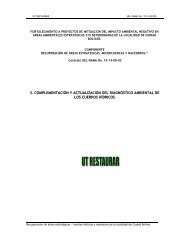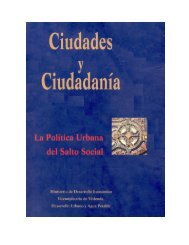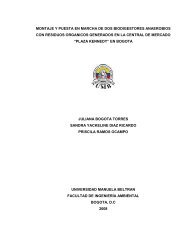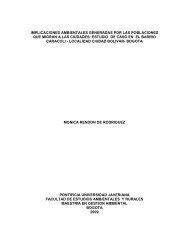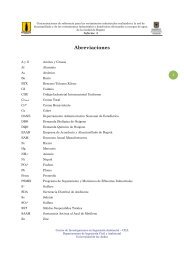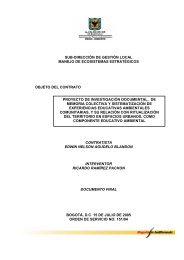Aire y problemas ambientales de Bogotá. - Observatorio Ambiental ...
Aire y problemas ambientales de Bogotá. - Observatorio Ambiental ...
Aire y problemas ambientales de Bogotá. - Observatorio Ambiental ...
You also want an ePaper? Increase the reach of your titles
YUMPU automatically turns print PDFs into web optimized ePapers that Google loves.
Contaminante Unidad Límite máximo<br />
permisible<br />
Guía OMS,<br />
actualización<br />
2005 8<br />
Tiempo <strong>de</strong><br />
exposición<br />
PST µg/m 100 -- Anual<br />
3<br />
300 -- 24 horas<br />
PM10 µg/m 70 20 Anual<br />
3<br />
150 50 24 horas<br />
SO2 ppm (µg/m 0.031 (80) (20) Anual<br />
0.096 (250) -- 24 horas<br />
3 )<br />
0.287 (750) (500, media <strong>de</strong><br />
10 minutos)<br />
3 horas<br />
NO2 ppm (µg/m 0.053 (100) (40) Anual<br />
0.08 (150) -- 24 horas<br />
3 )<br />
0.106 ( 200) (200) 1 hora<br />
O3 ppm (µg/m 0.041 (80) (100) 8 horas<br />
3 )<br />
0.061 (120) (160) 1 hora<br />
CO ppm<br />
(mg/m<br />
8.8 (10) -- 8 horas<br />
3 ) 35 (40) -- 1 hora<br />
Nota: mg/m 3 o µg/m 3 : a las condiciones <strong>de</strong> 298,15°K y 101,325 KPa. (25°C y 760 mm Hg).<br />
Parágrafo 1º. El límite máximo permisible anual <strong>de</strong> PM10 en el año 2009 será 60 µg/m 3 y en el<br />
año 2011 será 50 µg/m 3 .<br />
En su comparación con la actualización <strong>de</strong> 2005 <strong>de</strong> calidad <strong>de</strong>l aire, cabe anotar<br />
la gran diferencia entre los valores <strong>de</strong> nivel máximo permisible para material<br />
particulado (PM10), dióxido <strong>de</strong> nitrógeno (NO2) y dióxido <strong>de</strong> azufre (SO2). Con l<br />
actualización <strong>de</strong> las guías <strong>de</strong> calidad <strong>de</strong>l aire en 2005, la OMS ha <strong>de</strong>jado un gran<br />
reto a los países para reducir significativamente la contaminación <strong>de</strong>l aire en sus<br />
centros urbanos.<br />
• Decretos 174, 325 y 417 <strong>de</strong> 2006, Alcal<strong>de</strong> Mayor. Clasificación a las localida<strong>de</strong>s<br />
<strong>de</strong> Puente Aranda, Fontibón y Kennedy, como áreas-fuente <strong>de</strong> contaminación<br />
alta, Clase I, por material particulado menor o igual a 10 micras (PM10). Adopción<br />
<strong>de</strong>l pico y placa ambiental, la cual ha exigido a los transportadores<br />
autorregularse con respecto al monitoreo y control <strong>de</strong> sus emisiones <strong>de</strong> material<br />
particulado.<br />
• Resoluciones 1015 y 3500 <strong>de</strong> 2005; 2200 y 5975 <strong>de</strong> 2006; 15 <strong>de</strong> 2007. Fijan los<br />
niveles <strong>de</strong> emisión <strong>de</strong> contaminantes <strong>de</strong> fuentes móviles a gasolina y diesel, las<br />
características <strong>de</strong> los centros <strong>de</strong> diagnóstico y la periodicidad <strong>de</strong> la revisión.<br />
• Ley 1083 <strong>de</strong> 2006 y Resolución 180158 <strong>de</strong> 2007, Ministerio <strong>de</strong> Minas y Energía<br />
(MME). Determinan los combustibles limpios a ser utilizados por sistemas <strong>de</strong><br />
transporte público <strong>de</strong> pasajeros. Incluye la exigencia <strong>de</strong> diesel <strong>de</strong> menos <strong>de</strong> 50<br />
ppm <strong>de</strong> azufre, entre otros.<br />
8 Air quality gui<strong>de</strong>lines - global update 2005. Disponible en:<br />
http://www.who.int/phe/health_topics/outdoorair_aqg/en/



